This incredible gluten-free pie crust is so flaky and buttery, your guests will never know its gluten-free! It's perfect for sweet or savory pies, hand pies, and pie dough cutouts.
This guide to gluten-free pie crust is beginner-friendly and full of tips to navigate the differences between regular and gluten-free pie dough.
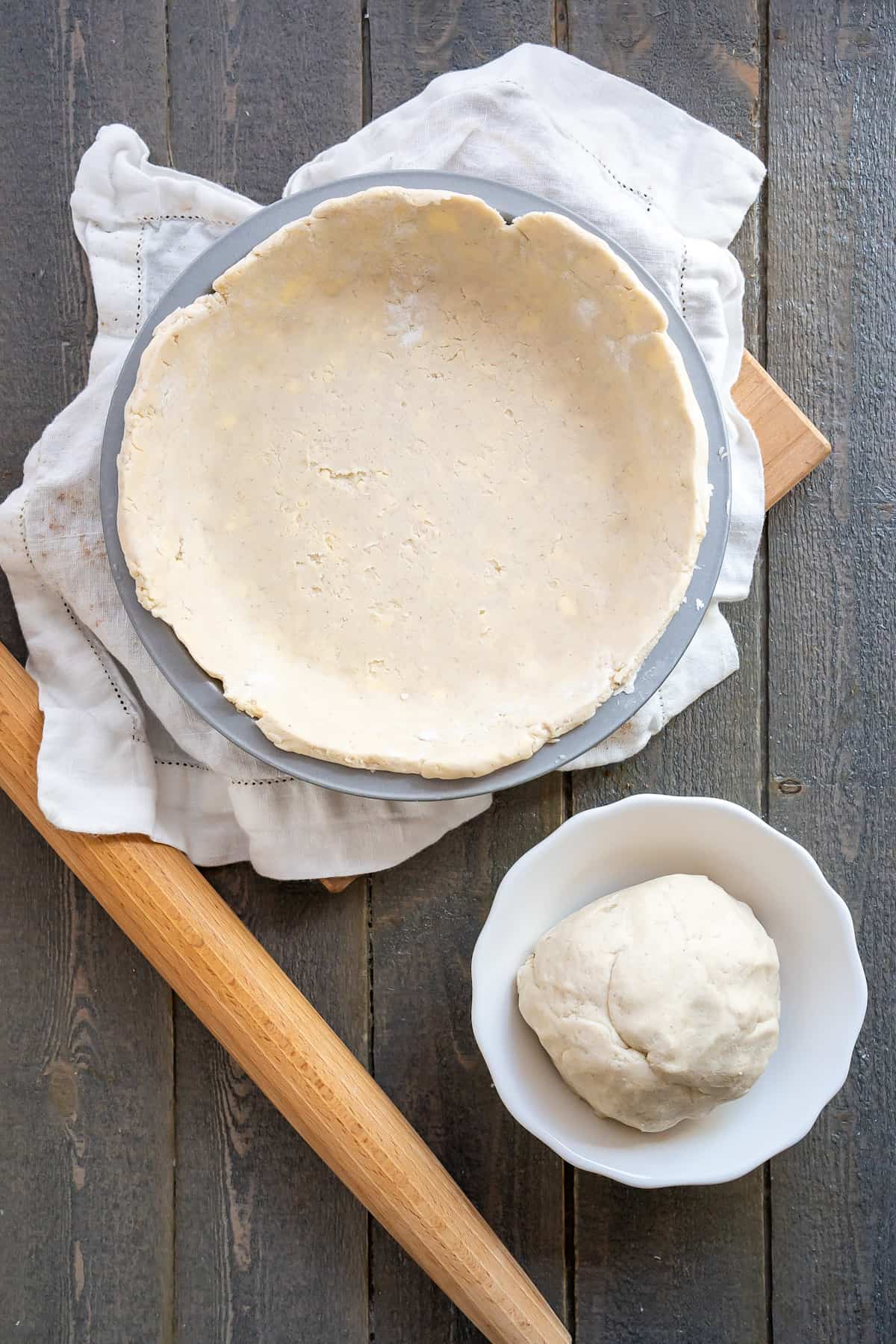
Jump to:
What makes gluten-free pie crust different?
While it tastes very similar to regular pie crust, a gluten-free pie crust must be handled a little differently. It is less stretchy and needs to be a little thicker than a regular pie crust. The texture of the dough is also a little more crumbly than a traditional pie crust.
Because of these differences, it is not a good idea to simply replace the flour in your old pie crust recipe with gluten-free flour. Gluten-Free Flour absorbs and holds water differently. In my tips section below, you'll find everything you need to know to get gluten-free pie crusts just right on the first try.
I recommend reading through this post in its entirety to get the best gluten-free pie crust.

When to make gluten-free pie crust
While pies are a year-round staple, I find myself making this gluten-free pie crust mostly for the Fall and Winter holidays, as well as the end-of-summer fruit pies. It's easy to make-ahead and I always make more than one crust. It refrigerates, freezes, and thaws well.
In preparation for Thanksgiving, I like to make pie crusts during the first week of November. This helps to minimize the prep needed during Thanksgiving week. It also prevents me from buying pre-made gluten-free pie crusts when I feel pressed for time.
I use this gluten-free pie crust recipe to make our family-favorite Gluten-Free Vegan Pumpkin Pie!
How to make it (with photos)
Ingredients + Substitutions
Gluten-Free Pie Crust only requires 4 ingredients plus water, just like a regular pie crust! The differences are found in the amount of each ingredient, and how the dough is handled.
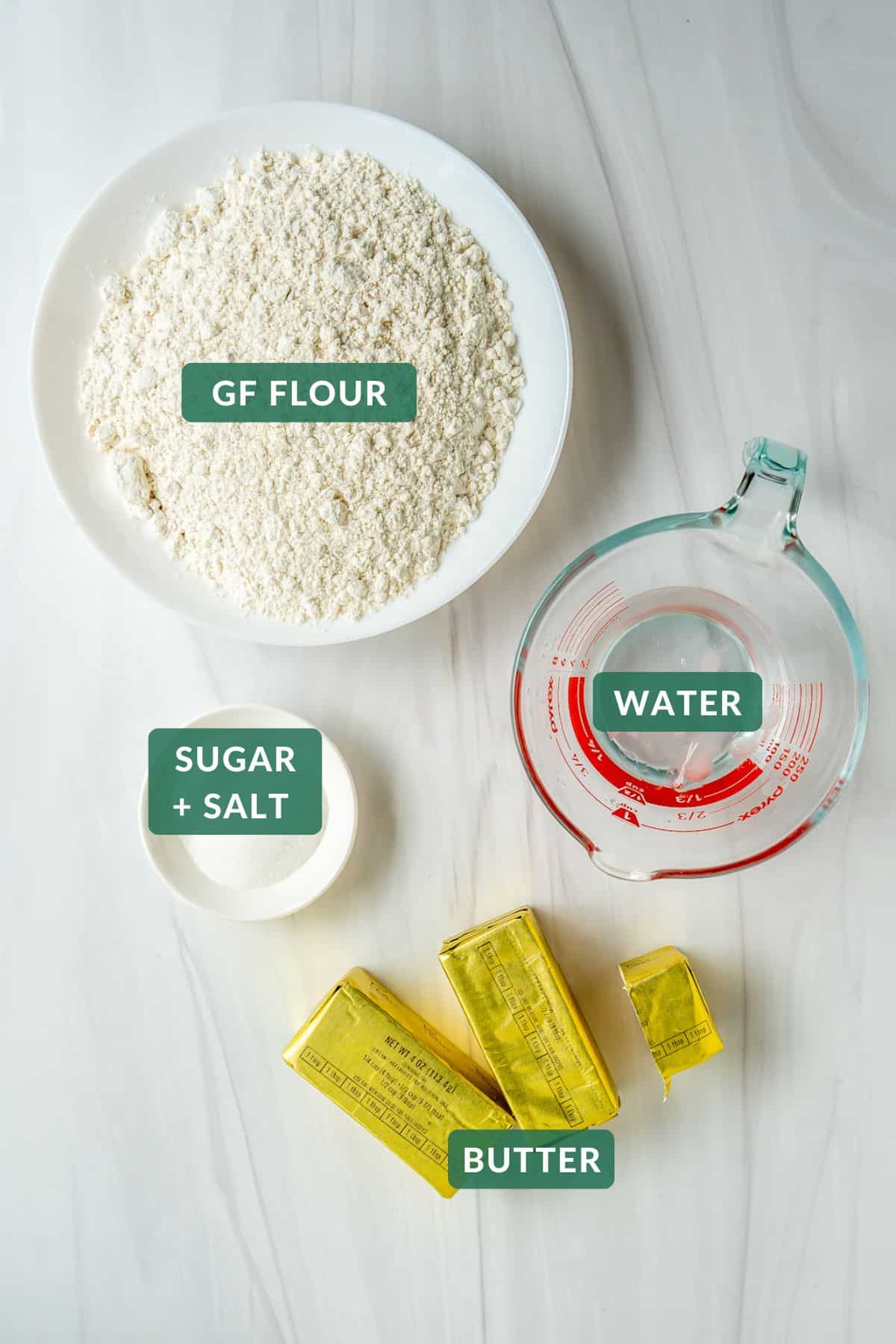
- Gluten-Free Flour - I used Bob's Red Mill 1-to-1 gluten-free Flour to make this recipe and I am very happy with the results! It is a rice flour blend that browns well. Other gluten-free All Purpose Flours made with rice flour will work well also. Rice flour blends taste the most like traditional wheat flour.
- Butter - Unsalted regular butter and dairy-free or vegan buttery sticks both work perfectly in this recipe. In preparation for this recipe, cut the butter into cubes about ½ inch wide. You want the butter to be very cold. I like to cube the butter first, then place it in a bowl in the freezer while I prepare the other ingredients. This keeps it very cold and encourages a super flaky crust! If using salted butter instead of unsalted, decrease the salt amount by ¼ teaspoon.
- Ice water - The ice should be mostly melted by the time it's added to the recipe. Immediately after cubing the butter (see butter notes above), I add ⅓ cup of cold tap water to a liquid measuring cup and add crushed ice until the total amount is ½ cup. The ice is usually mostly melted by the time I need it.
See the recipe card for full ingredients and quantities.
Instructions
This is an easy beginner-friendly recipe. I broke the process down into simple steps. Instructions using a pastry cutter or food processor are included in each step.
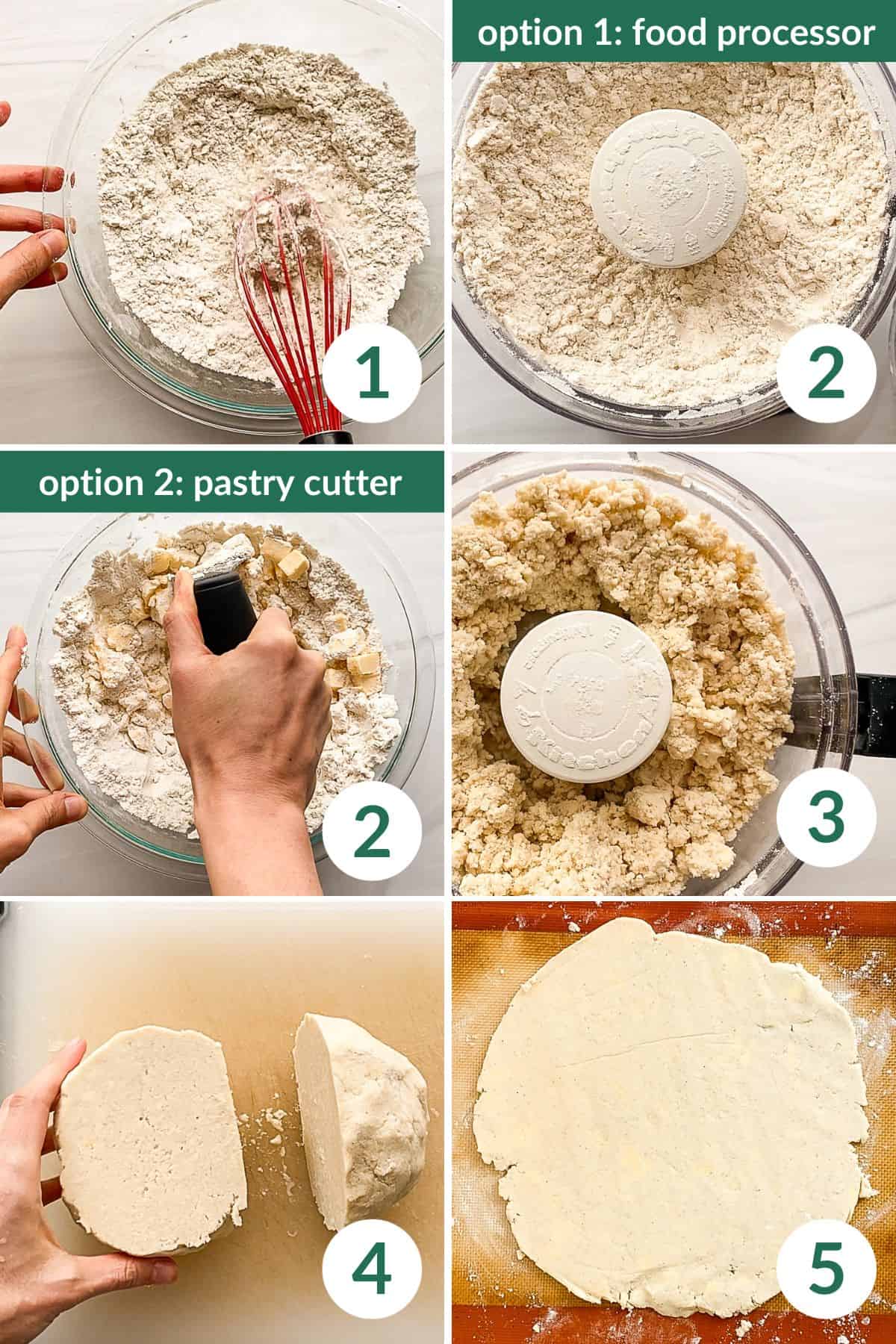
- Dry Ingredients: Add the gluten-free flour, sugar and salt to a food processor and pulse until lightly mixed. Alternatively, add these ingredients to a large mixing bowl and whisk together.
- Butter: Add the cold cubed butter to the gluten-free flour mixture. Pulse in the food processor or cut with a pastry cutter until the butter is broken into pea-sized pieces.
- Water: Add half of the ice water, pulse a few times to lightly mix, then add the remaining ice water. Pulse or mix until a crumbly dough forms.
- Dough: Transfer the dough from the food processor to a mixing bowl. Use your hands to lightly mix and consolidate the dough into a ball. Do this step quickly and don't overdo it since your hands will begin to melt the butter. It is ok if bits of dry flour remain, but there should be no large pockets of flour. Use a sharp knife to split the dough into two equal parts, since this recipe makes two crusts. Cover the bowl with plastic wrap and place it in the refrigerator for at least 2 hours, or up to 5 days.
- Roll: When ready to use the pie crust, first lay a large silicone liner or piece of parchment paper on your surface. Dust with flour, then place one of the the pie crust dough balls on top. Dust the top of the dough ball with flour, and then lay a piece of parchment paper on top. Use a rolling pin to roll the dough into a large thin disk, ½ inch wider than your pie plate on all sides.
- Pie Plate: Remove the top layer of parchment paper. Then gently lay your pie plate upside down and centered over the rolled dough. Carefully flip the crust into the pie plate by wedging your hand under the bottom layer of parchment paper and turning the dough and plate over at the same time. Gently remove the parchment paper from the dough and use your fingers to nestle the pie crust into the pie plate. Trim any extra dough extending from the edges and smooth or crimp the dough with your fingers for a decorative edge. From here, follow your pie recipe's instructions for the crust.
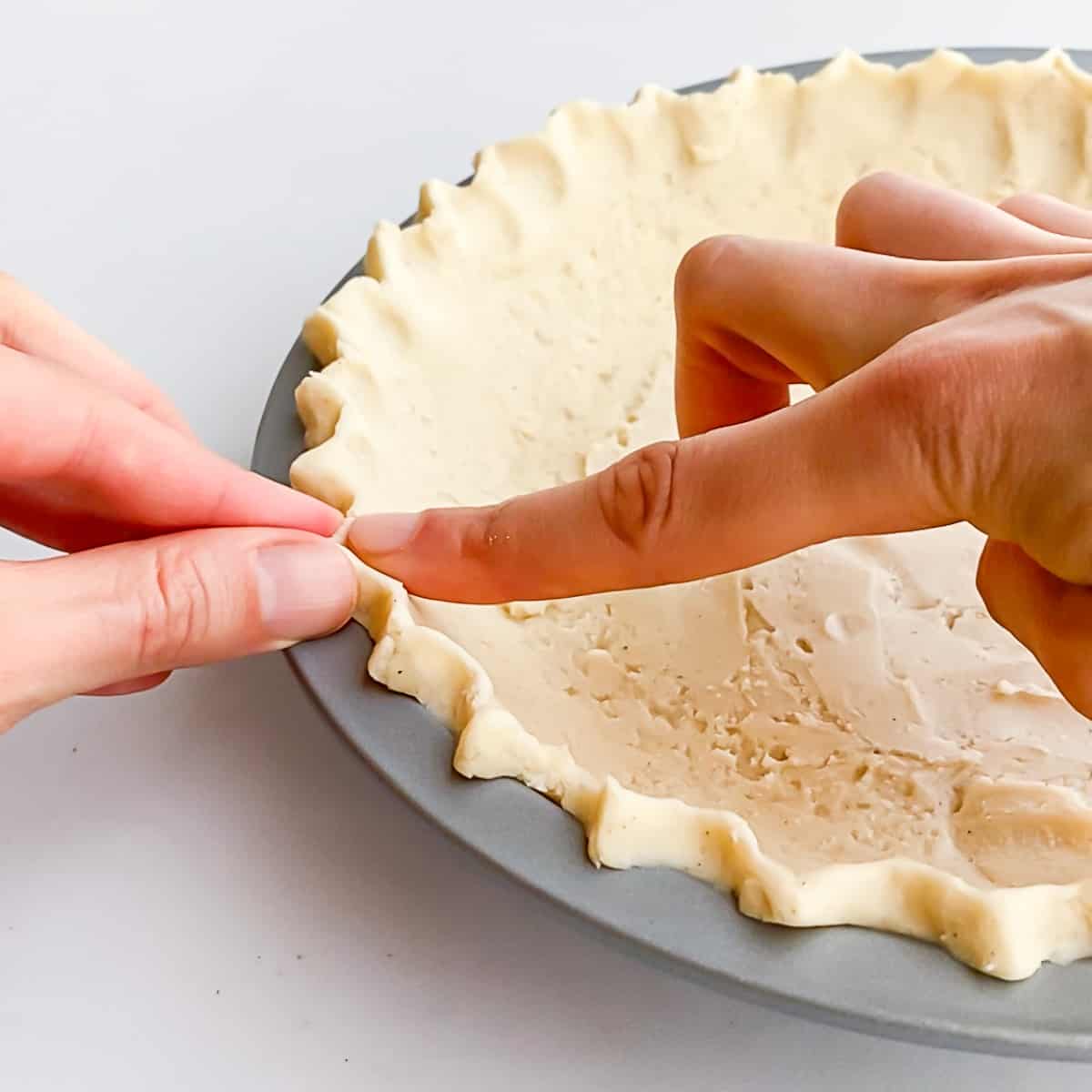
Hints: You don't need to grease a pie plate. Pie crusts are so buttery they don't tend to stick. When baking, place your pie plate on top of a baking sheet. That way any butter or juices from the filling that bubbles out won't dirty your oven.
Equipment
I recommend using either a food processor or a pastry cutter for this recipe. Both of these methods keep your hands out of the dough so the butter stays cold, which keeps the crust flaky.
If you don't have a food processor or pastry cutter, you can use your hands. Make sure the butter is very cold. I recommend cubing it and then placing it in the freezer for 20 minutes before using. Then when it's time to mix in the butter, squish your hands through the dry ingredients and cubed butter until there are pea-sized lumps of butter remaining (same as the other methods). For more information on this method, check out my Gluten-Free Blueberry Scones recipe. I find using my hands to be very therapeutic.
You also need:
- mixing bowl
- rolling pin
- parchment paper or large silicone baking sheets
- 8 or 9 inch pie plate

Storage + Freezing
This gluten-free pie crust recipe is great for same-day use or to make ahead of time.
Here's how to store it propertly:
- Store uncooked dough in an airtight container in the refrigerator for up to 5 days.
- Freeze for up to 3 months and allow to thaw in the refrigerator overnight before using.
Tips + Troubleshooting
While this gluten-free pie crust is just as good as a traditional pie crust, the dough does behave a little differently. Use these tips to get the best gluten-free pie crust whether you're new to pie making or an expert trying it gluten-free!
Tip 1. Keep the butter cold and the ice water colder for a flaky crust.
Prepare the butter at the very start of the recipe. Cube it for use later, than place it in a bowl and put it in the freezer while you prepare the other ingredients.
Immediately after preparing the butter, add ⅓ cup of water to a liquid measuring cup and add crushed ice until the total amount is ½ cup. Then stir and allow to sit at room temperature so the ice can melt and superchill the water.
Tip 2. The dough may seem crumbly, and that's ok.
To get a nice flaky pie crust, I found that the dough needed to be drier than what I was used to pre-gluten-free. After mixing the ingredients together, your hands are needed to press the dough together. However, if you add more water (like you would with regular pie crust), the dough gets very sticky very quickly and is impossible to work with.
Tip 3. Keep your hands off the dough until after refrigeration.
The less you handle the dough with your hands, the better. That's why we sandwich the dough between a floured silpat mat and/or parchment paper. After refrigeration, use your fingers only as needed to nestle the crust in the pie shell and add a decorative edge.

Tip 4. Don't stretch the dough.
It simply will not stretch. Gently nestle it into the pie shell by pushing with your fingers. Be very careful when lifting pieces for braiding or creating a lattice top. To seal a top and bottom crust, overlap the pieces slightly and very gently push or pinch the pieces together.
Tip 5. Repair cracked edges with dough "patches".
If the edges begin to crack when rolling or filling in the pie plate, use extra pieces of dough to patch the holes. Roll out the pieces and then gently press them into the cracks or holes with your fingers. Only use a little ice water if the dough is very very dry.
Tip 6. Go for a thick pie crust.
This dough does not stretch and requires gentle handling. This is much easier when the crust is thick. Only roll the dough out as much as you need to fit your pie plate.
Recipe FAQs
Hopefully I've covered some of your burning questions about making this gluten-free pie crust! If not, leave a question in the comments and I'll get back to you within two business days.
Leave the pie crust at room temperature for no more than 5-10 minutes before rolling. Otherwise, you risk losing its flakiness.
The holes in the bottom crust prevent bubbles from forming and bursting when the steam rises.
Unchilled pie dough is less flaky and more dense. It is also more likely to break apart and is therefore more difficult to work with.
To grate the butter, first make sure it is very cold. Then use a cheese grater and mix into the dry ingredients. This recipe works great with cubed or grated butter.
To cube butter, cut cold butter sticks into ½ inch (1 cm) cubes. I like to do this by slicing the butter twice along it's length on two sides to create 9 equal sections on the short sides. Then slice into cubes and place in the freezer to keep cold while you prepare the other ingredients.
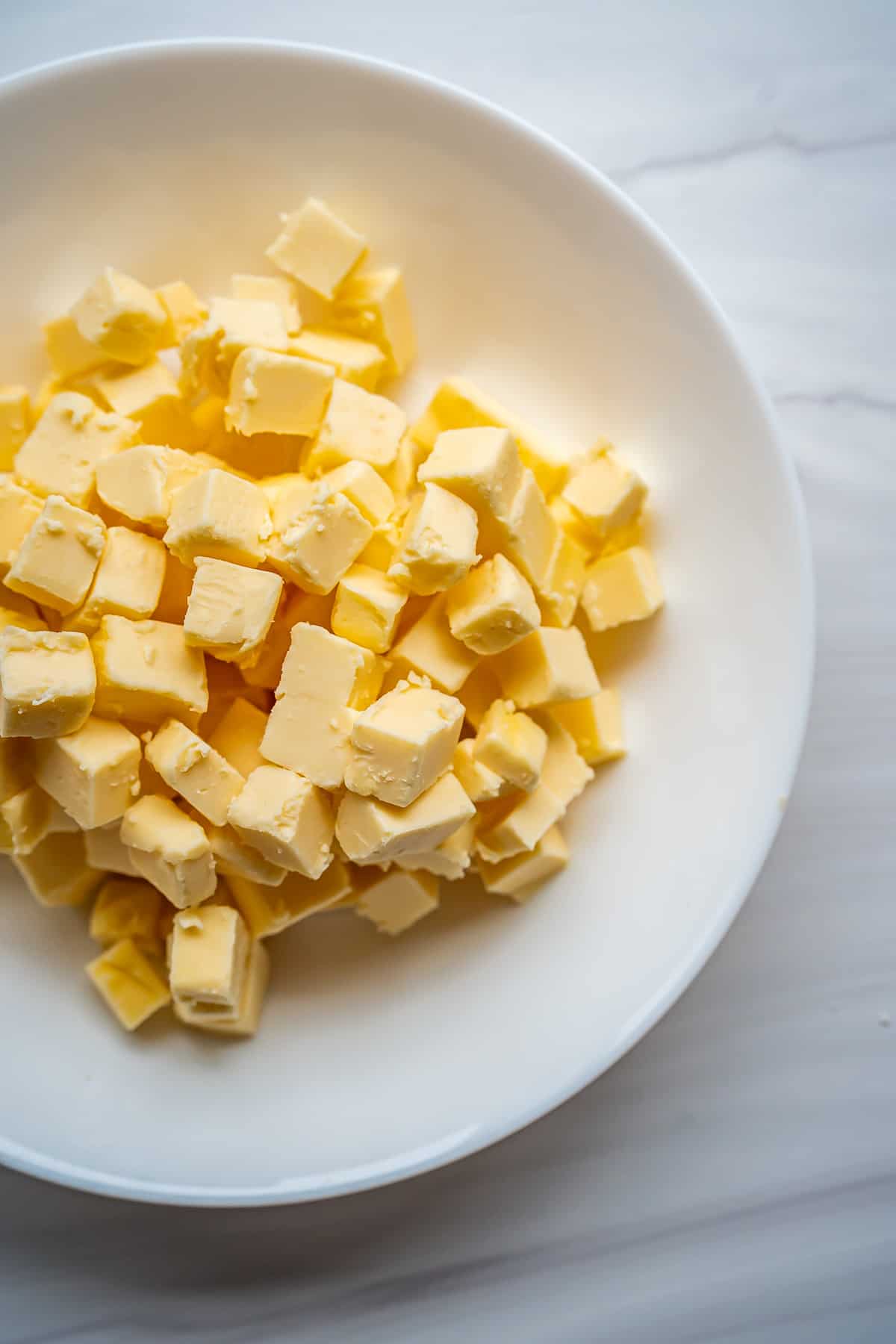
Related gluten-free pie recipes to try...
Looking for more gluten-free pie recipes like this flaky gluten-free pie crust? Check these out:
For more classic gluten-free treats, check out my Dairy Free Brownies, Vegan Gluten-Free Chocolate Chip Cookies, Gluten Free Double Chocolate Muffins, and Dairy-Free Whipped Cream!
Love this recipe? Please leave a 5-star 🌟🌟🌟🌟🌟 rating in the recipe card or comment field below. Thank you!
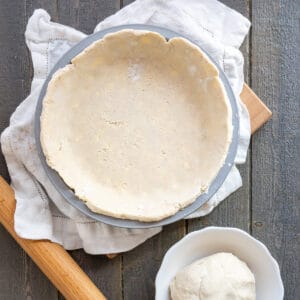
Gluten Free Pie Crust
Equipment
- 2 pieces of parchment paper or silicone liners
Ingredients
- 2 ½ cups gluten-free all purpose flour (337 grams)
- 1 tablespoon granulated sugar
- 1 teaspoon salt use ¾ teaspoon if using salted butter
- 18 tablespoons unsalted butter or vegan butter , cubed (2 sticks plus 2 tablespoons, 9 ounces, or 255 grams)
- ½ cup ice water
Instructions
- Dry Ingredients: Add the gluten-free flour, sugar and salt to the food processor and pulse until lightly mixed. Alternatively, add these ingredients to a large mixing bowl and whisk together.
- Butter: Add the cold cubed butter to the gluten-free flour mixture. Pulse in the food processor or cut with a pastry cutter until the butter is broken into pea-sized pieces.
- Water: Add half of the ice water, pulse a few times to lightly mix, then add the remaining ice water. Pulse or mix until a crumbly dough forms.
- Dough: Transfer the dough from the food processor to a mixing bowl. Use your hands to lightly mix and consolidate the dough into a ball. Do this step quickly and don't overdo it since your hands will begin to melt the butter. It is ok if bits of dry flour remain, but there should be no large pockets of flour. Use a sharp knife to split the dough into two equal parts, since this recipe makes two crusts. Cover the bowl with plastic wrap and place it in the refrigerator for at least 2 hours, or up to 5 days.
- Roll: When ready to use the pie crust, first lay a large silicone liner or piece of parchment paper on your surface. Dust with flour, then place one of the pie crust dough balls on top. Dust the top of the dough ball with flour, and then lay a piece of parchment paper on top. Use a rolling pin to roll the dough into a large thin disk, ½ inch wider than your pie plate on all sides.
- Pie Plate: Remove the top layer of parchment paper. Then gently lay your pie plate upside down and centered over the rolled dough. Carefully flip the crust into the pie plate by wedging your hand under the bottom layer of parchment paper and turning the dough and plate over at the same time. Gently remove the parchment paper from the dough and use your fingers to nestle the pie crust into the pie plate. Trim any extra dough extending from the edges and smooth or crimp the dough with your fingers for a decorative edge. From here, follow your pie recipe's instructions for the crust.
Video
Notes
- If you made regular pie dough before this gluten-free pie crust, this dough will likely feel drier than what you are used to. Do not add extra water unless it is difficult to push the dough together into a ball. Use a kitchen scale to measure the flour if possible, so you know that the flour to water ratio is accurate.
- See the post for step-by-step photos and helpful tips for making pie crust. Gluten-Free pie dough and regular pie dough definitely behave a little differently. The tips include things like keeping the dough on the thicker side and not expecting it to stretch.
- You don't need to grease a pie plate. Pie crusts are so buttery they don't tend to stick.
- When baking, place your pie plate on top of a baking sheet. That way any butter or juices from the filling that bubbles out won't dirty your oven.
- Storage: Store uncooked dough in an airtight container in the refrigerator for up to 5 days. Freeze for up to 3 months and allow to thaw in the refrigerator overnight before using
- Dairy-Free + Vegan: Simply use dairy-free or vegan butter in place of the butter in this recipe. I linked my favorite brand for pie-making in the instructions section of the blog post.




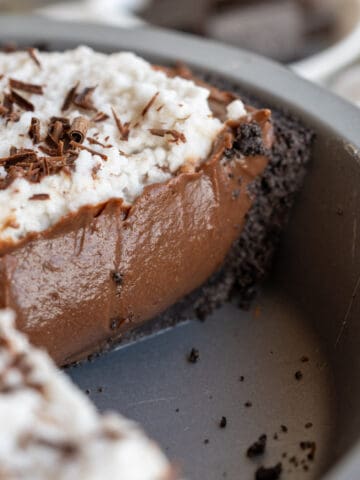
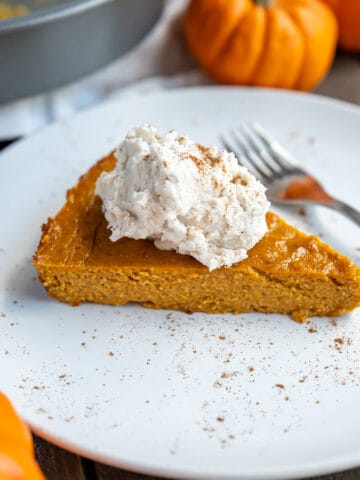

Kendall
This is my go to recipe! Just a solidly delicious gf pie crust that’s also very easy. Thank you!
Vero
This recipe made my holiday! I made no less than 8 pies following instructions as written. Actually the last two I used half shortening like a previous comment said. We liked both variations. I’m absolutely thrilled to find gf recipes that taste legit! Keep doing what you do!
Vero
I want to add that I actually prefer the version with less ingredients to start, like just butter. If it was more complicated I probably would have been too scared to try. Like the gf apple fritters that are so simple I just had to give it a try! More recipes like this please!
Jamie
I appreciate the feedback and I'm so glad you enjoyed the pie crusts!
Meg
I made this exactly as listed for Thanksgiving, and it was a hit for everyone! This will be my go to pie crust recipe from now on.
Sonya
Jamie, this is a great recipe! I made one change (because I didn’t have enough vegan butter for 4 single crust and 1 double crust pie)
I used half blue bonnet plant butter (in the tub) and 1/2 Spectrum palm shortening. No other changes and all the pies came out perfectly. Your instructions are spot on! Thank you!
Leila
I just made this yesterday! I wanted to come back and thank you for making such an easy recipe. I used my neglected food processor and was so thrilled to have it turn out on my first try! Thank you for the recipe!
Jennifer
I love this pie crust! It absolutely does taste flaky and buttery. I used the food processor method and it could not be easier. The photos are so helpful and so is the video! Thank you!